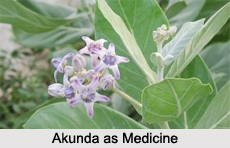 Calotropis gigantea, commonly known as Akunda is a medicinal plant that is used widely in the traditional system of medicine in India. Sanskrit writers mention two varieties founded upon the colour of the flowers, namely, white called "Alarka" and red called "Arka".
Calotropis gigantea, commonly known as Akunda is a medicinal plant that is used widely in the traditional system of medicine in India. Sanskrit writers mention two varieties founded upon the colour of the flowers, namely, white called "Alarka" and red called "Arka".
Health Benefits of Akunda
The milky juice, flowers, root- bark and leaves are all used in medicine. The root-bark is said to promote the secretions and to be useful in skin diseases, enlargements of the abdominal viscera, intestinal worms, cough, ascites, anasarca, etc. The milky juice is regarded as a drastic purgative and caustic and is generally used as such in combination with the milky juice of Euphorbia neriifolia. The flowers are considered digestive, stomachic, tonic and useful in cough, asthma, catarrh and loss of appetite.
Dose of Akunda in Medicine
The leaves mixed with rock salt are roasted within closed vessels, so that the fumes may not escape. The ashes thus produced are given with whey in ascites and enlargements of the abdominal viscera.
The following inhalation is prescribed for cough. Soak the powdered root-bark of arka in its own milky juice and dry. Bougies are prepared with this powder and their fumes inhaled. The root-bark, reduced to a paste with sour congee, is applied to elephantiasis of the legs and scrotum. The milky juices of Calotropis gigantea and Euphorbia neriifolia are made into tents with the powdered wood of Berberis Asiatica, for introduction into sinuses and fistula in anus. The milky juice is applied to carious teeth for relief of pain.
This article is a stub. You can enrich by adding more information to it. Send your Write Up to content@indianetzone.com
Related Articles
Ayurveda
History of Ayurveda
Origin of Ayurveda
Ayurveda Medication
Elements of Ayurveda
Concepts of Ayurveda
Ancient Literature of Ayurveda
Sushruta Samhita
Properties of Material Objects and its Effect on Human Body




















